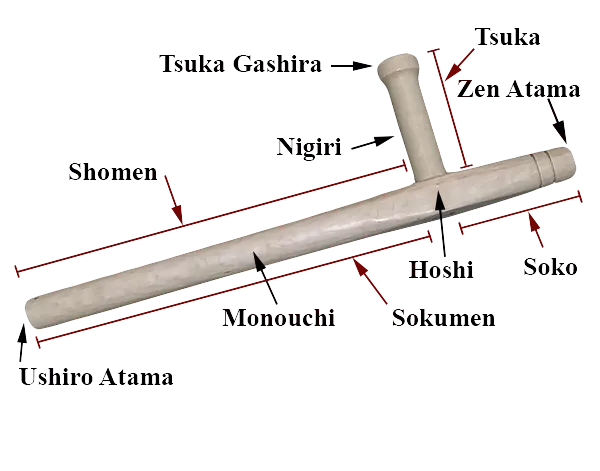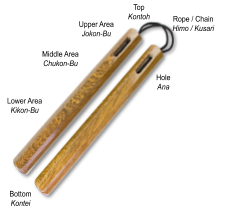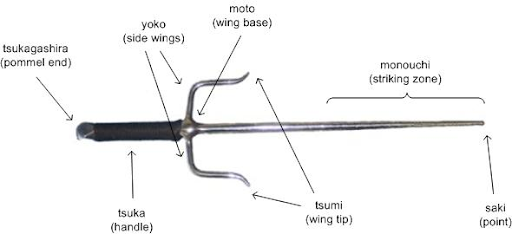Kobudo
Kobudo History and Facts
History
Kobudo (kō-boo-dō) is a style of martial art that incorporates several different weapons and empty-hand styles under one name, and is primarily known in the martial arts world for its Okinawan and Japanese weapons. While many specific facts about the history and origin of Kobudo are widely disputed, it is generally agreed that many of the weapons used in this style evolved from common Okinawan farming tools, due to the restrictions imposed on commoners by the Samurai clans during the Edo period (1603-1868). During this time, only samurai and soldiers under the shogunate were allowed to carry arms or edged weapons. As a result, commoners began to develop a fighting system around common farm implements and staffs. Again, this origin is widely disputed, and many historical scholars believe that Kobudo likely evolved from Chinese roots and was practiced over the generations by those of warrior and common classes alike throughout Asia. Modern Kobudo began to take its current shape in the early 20th century alongside many of the empty-hand arts practiced today.
Kobudo at ECMA
Today, Kobudo still varies in its scope from dojo to dojo, and can include one, two, or a dozen weapons, often taught alongside empty-hand martial arts. At Emerald Coast Martial Arts Academy, we primarily study five of the traditional Kobudo weapons: Bo, Jo, Tonfa, Nunchaku, and Sai. Our style of Kobudo blends the modern with the traditional to create a style that is practical and tailored for each student’s needs. In our system, students are allowed to study any of the weapons in any order. However, to advance to black belt, a strong foundation must be laid with knowledge in all of the five weapons. Typically, students will select one or two weapons that will be the backbone of their training, but will gain hands-on experience with a variety of weapons during the course of their studies. Students interested in Kobudo do not need to have any prior martial arts experience, but training in empty-hand or weapons-based martial arts will definitely speed up your progression. Most of our students have trained in other martial arts and have a foundation to include proper stances, combative concepts, and general discipline. However, any student new to Kobudo at ECMA will be equipped with the tools to succeed, regardless of prior experience.
Bo
The Bo is typically a six foot staff, sometimes tapered at either end. Often, a Bo will be shortened with smaller students to match their height. The origin of the bo is widely disputed, but humans have been using sticks and staffs to defend themselves long before written history. Modern Bo techniques and disciplines likely owe their lineage to Chinese martial arts and the monks who practiced them. The Bo is certainly the oldest weapon in Kobudo and likely one of the first weapons to be stylized into the martial arts. Today, Bo is the most widely practiced weapon in the martial arts world.

Jo
The Jo is a staff usually 4 foot in length, or cut to the height of the base of the practitioner’s shoulder. The jo’s history and origin is still disputed, but it is widely believe that one of it’s early inventors or practitioners was Musō Gonnosuke Katsuyoshi. Scholars of the time reported that he and Miyamoto Musashi (a famous swordsman) dueled sometime in the early 1600s. While the precise dates, locations, and even weapons used, are still disputed, it is generally agreed that Gonnosuke lost this duel and afterwards sought to create a more practical staff to defeat the sword. The result was the Jo. To this day, the Jo is a formidable weapon that combines the techniques of the Bo and Sword to create a very flexible, efficient fighting tool.
Tonfa
The Tonfa is a hand-held weapon that is typically used in pairs. However, sometimes a single Tonfa is used. Its history and origin are unknown, but it may have originated from a variety of common household tools. Today, many police around the world still train in Tonfa techniques in the form of police batons. Many Tonfa techniques resemble empty-hand techniques, making this a fairly easy weapon to pick up and train.

Nunchaku
The Nunchaku is made from two sections of wood connected by a cord or chain. Modern Nunchaku can be made with a variety of materials, but wood is by far the most common and traditional. Okinawan Nunchaku are often octagonal, while many Chinese Nunchaku are rounded. The octagonal shape creates more sharp edges, increasing the potential damage to an opponent. Modern Nunchaku has been popularized by martial arts greats such as Bruce Lee and others.

Sai
The sai is a three-pronged weapon made from steel or other metals. Sais used for combat are typically made from steel, where some sais for competition or training can be made from aluminum or even rubber. The sai has one of the most disputed and unknown origins, as it is one of the only metal weapons in Kobudo. As we know it today, the Sai was likely developed as a dull weapon that could withstand strikes and cuts from an edged blade such as a sword. Sai is typically used in pairs, and presents itself as a formidable weapon in the hands of a trained user.

